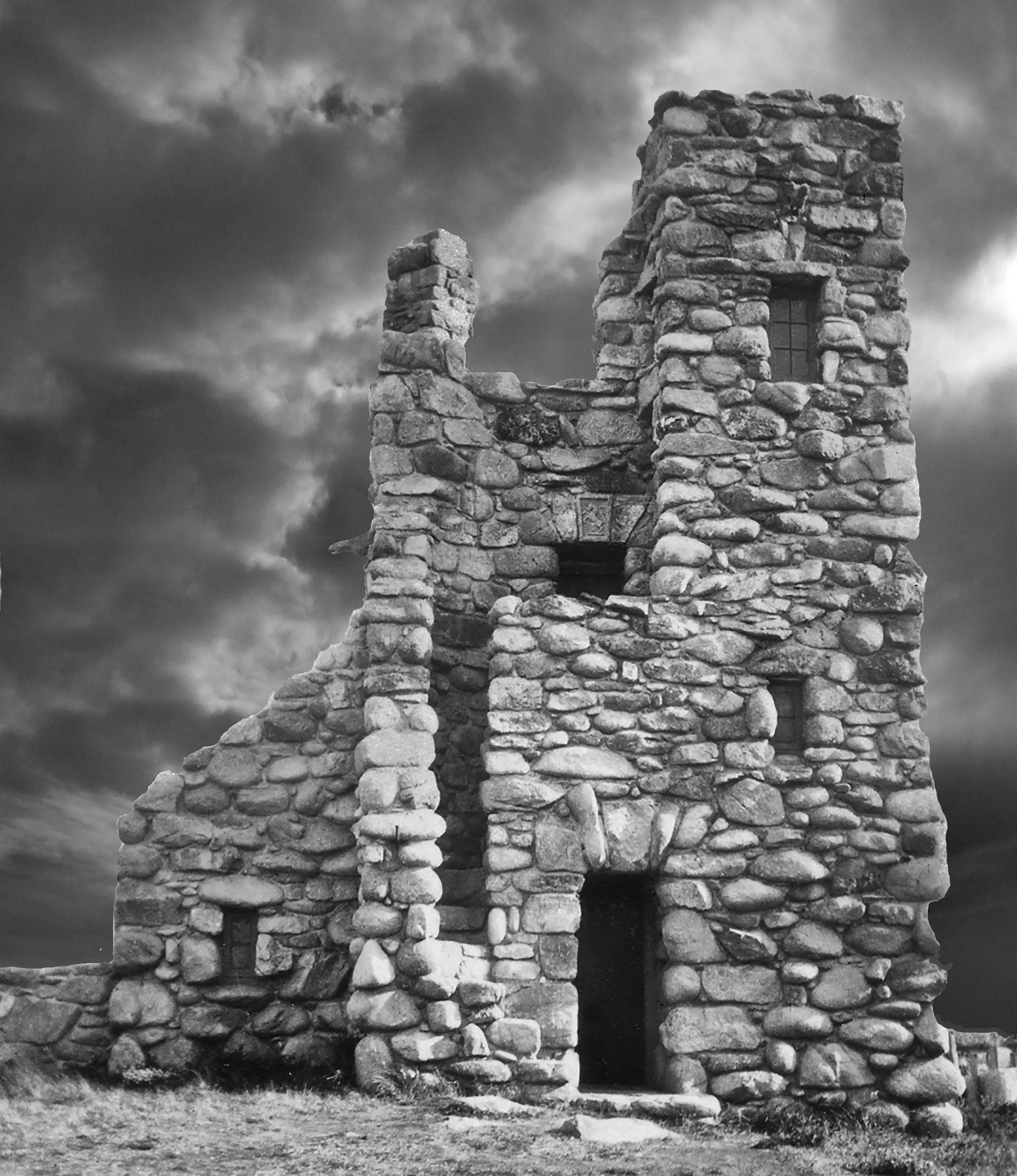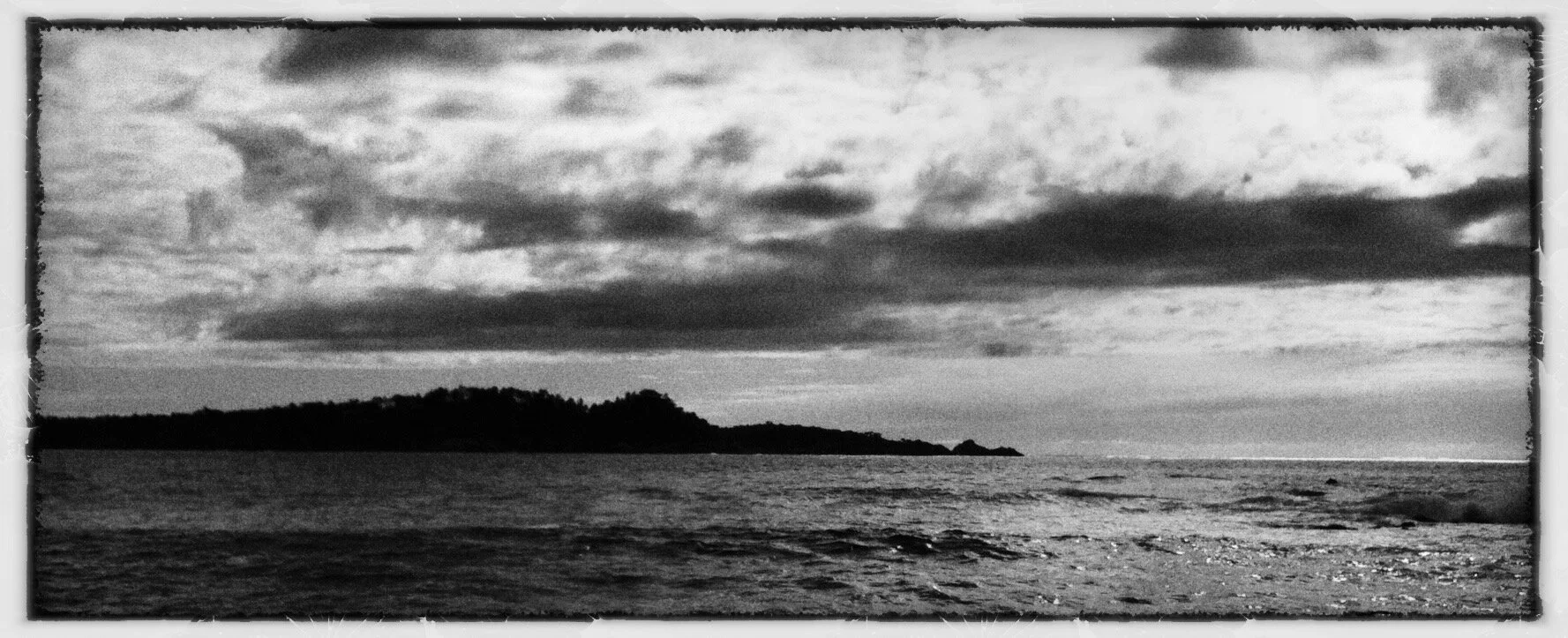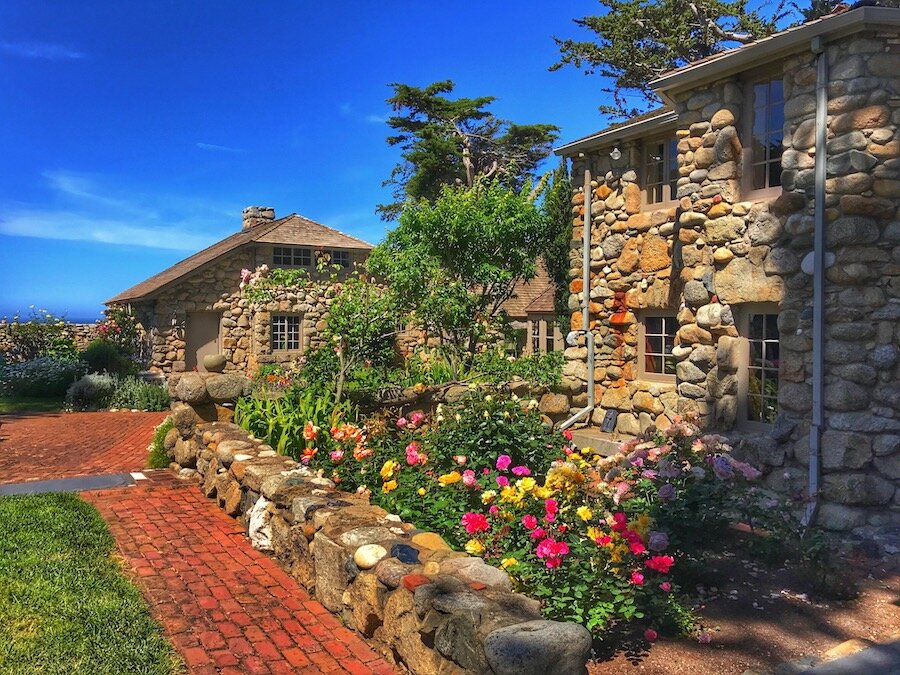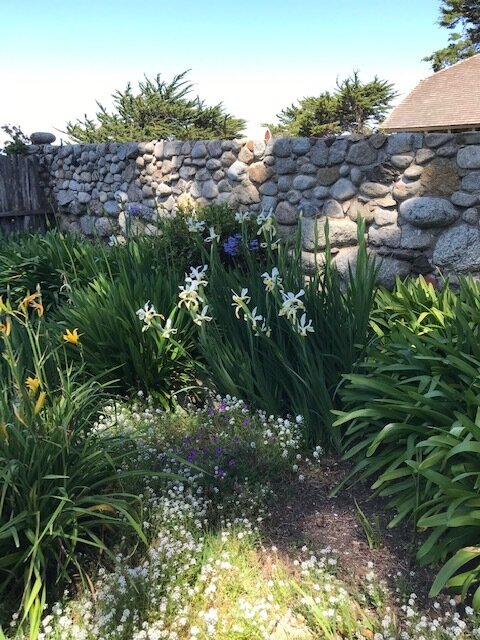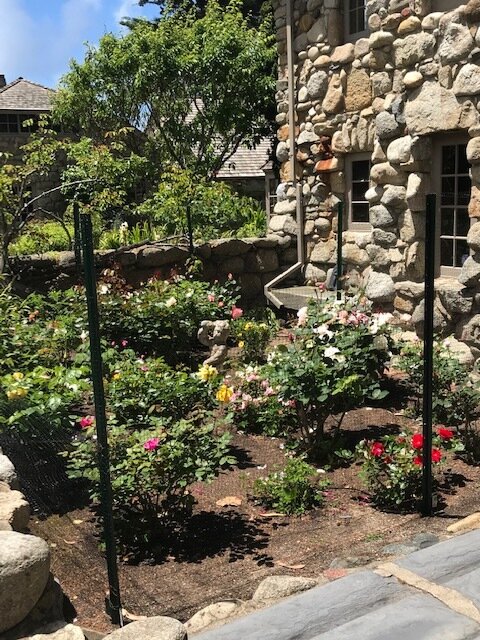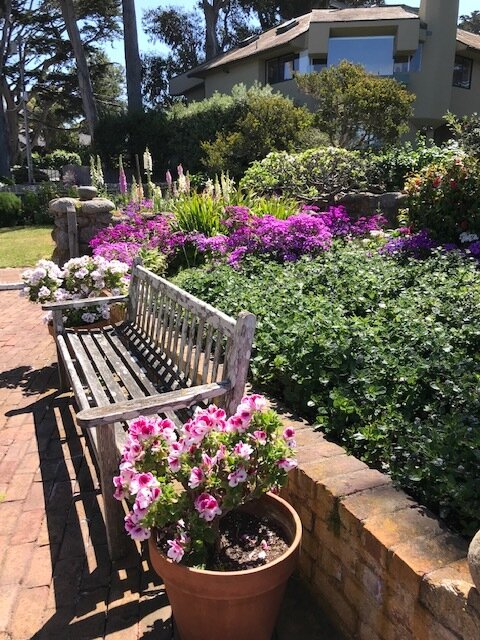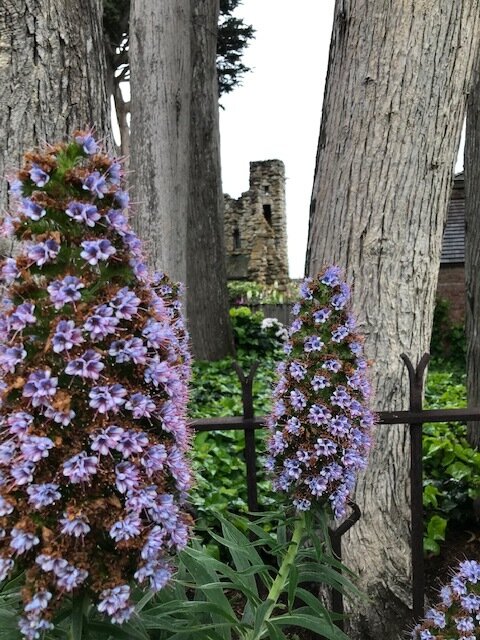A talk by James KarmAn at the Robinson Jeffers Tor House Foundation Fall Festival 2025
2025 marks the 100th anniversary of the publication of Robinson Jeffers’ Roan Stallion, Tamar and Other Poems, and the completion of Hawk Tower. At this year’s Fall Festival, we explored the enduring legacy of these two milestones and celebrated the recent designation of Tor House as a National Historic Landmark. At the Lectures and Talks given on October 4th, we began with three presentations that provided a wide-ranging review of what was happening globally in 1925, in Carmel-by-the-Sea, CA, and at Tor House. This third talk is by James Karman, professor emeritus of English and Comparative Religion & Humanities at California State University, Chico, and a trustee of the Tor House Foundation. He presented a sequence of letters from Robin and Una that describe life at Tor House in 1925.
You can read the first 1925 talk by Professor Richard Kezirian on the historical global highlights of 1925 here.
The second 1925 talk, given by Karen Ferlito, focused on the evolution of Carmel and the surrounding landscapes that made it the international attraction that it is today. You can read Karen’s talk here.
Letters from TOR HOUSE 1925
At the beginning of 1925 Jeffers was an unknown poet working on an unfinished tower. By the end of the year, Hawk Tower was completed and Jeffers was hailed as the greatest poet in America. Here is a brief chronology of events and milestones along the way, based primarily on excerpts from The Collected Letters of Robinson Jeffers, with Selected Letters of Una Jeffers.
April 1924
Tamar and Other Poems was published by Peter Boyle in New York. Jeffers paid for the printing himself, so when very few copies were sold, the bulk of the order was shipped back to Carmel for storage at Tor House.
Soon after, Jeffers was invited by George Sterling (writing on behalf of co-editors James Rorty and Genevieve Taggard) to submit poems for inclusion in an anthology planned for publication by the Book Club of California. Jeffers was “known” (ever so slightly) because he had published a book of poems titled Californians eight years before.
When Jeffers responded to the invitation, he sent Sterling and Rorty copies of Tamar. Sterling responded with lavish praise, and a warm friendship was established, which grew stronger through the summer and fall. At the same time, Sterling and Rorty began sending copies of Tamar to fellow poets and influential critics in New York.
November 22, 1924 (CL 1: 477)
RJ to George Sterling
We have had carpenters in the tower all this week panelling Una’s little room with Japanese oak, and it is such a wonder of a little place now with its deep window-embrasures and carved hawks and unicorns and motto from Virgil, [“We make our own dreams”] that I’d like to show it to you, and am sure that she would.
Monday they’ll begin on the boys’ room down-stairs, and that will soon be habitable; though the parapets are not finished and most of the winter will go by before my turret is.
I’ve made, though not completed, a poem about Clytemnestra and her family [The Tower Beyond Tragedy] that I’d like to inscribe to you, if you’ll let me, when—and if—it comes to publication.
January 6, 1925
Una’s birthday: 41 years old.
January 10, 1925
Robinson’s birthday: 38 years old.
January 21, 1925 (CL 1: 478)
RJ and UJ to George Sterling
Here is the poem I thought of inscribing to you, and here are stamps to send it back with when you’re done looking. I think I shan’t offer it to be published, I don’t see why anyone should want to read about Mycenae. And the best part of publication is showing it to G. S., which I do herewith. Sometime I’ll write something more amusing, and dedicate it to you, if you’ll let me.
This is my first letter of 1925, or indeed for awhile before, we’ve been so occupied with the little rooms in the tower, and celebrating the children’s holidays.
February 1925 (CL 1: 483–84)
UJ to Hazel Pinkham
I cant remember how much or little I’ve told you about my tower room. Its enchanted—thats it— The woodwork beautiful—the waxings brought out the carvings beautifully. —I got my things arranged after head-breaking thought, and there seems to be lots of space, more than before the things were put in and yet everything necessary is there. The day-bed, melodeon & stool, small {hand} carved oak chair (English ’tis), carved all over with leaves, did you see it? I had it upstairs—in the center of the seat was a tiny shield with some raised letters (monogram) on. —My wood carver cut off the finials and then cut down into the wood “Hawk Tower.” —my books and two brass sconces and four pictures {(a Dürer, an etching of Mission by Armin Hansen, a very old woodcut of an Irish Round tower and Robin)}and a rug and some little things—hourglass, crystal ball and that carved {ivory colored pottery} casket you gave me, isnt it a copy of one in the Campo Santo, Pisa?—incense in it.
March 1, 1925
Review of Tamar and Other Poems by James Rorty published in the New York Herald Tribune.
“I am convinced,” Rorty wrote, “that no poet of equal potential importance has appeared on the American scene since [Edward Arlington] Robinson.” / “the net effect of Tamar is that of a magnificent tour de force. It is enough. Nothing as good of its kind has been written in America.” / “America has a new poet of genius.”
March 11, 1925
Review of Tamar by Mark Van Doren in the Nation. “Few recent volumes of any sort have struck me with such force as this one has,” Van Doren exclaimed; “few are as rich with the beauty and strength which belong to genius alone.”
May 15, 1925
Publication of Continent’s End: An Anthology of Contemporary California Poets by the Book Club California, edited by George Sterling, James Rorty, and Genevieve Taggard, with a poem by Jeffers selected for the title and frontispiece.
May 27, 1925
Review of Tamar by Babette Deutsch in the New Republic, who confessed to being so overwhelmed with the book that, when she turned the last page, she “felt somewhat as Keats professed to feel, on looking into Chapman’s Homer.”
June 1, 1925 (CL 1: 493–94)
UJ to Hazel Pinkham
We have lately been tramping a good deal. A week ago we walked ten miles {(5 up—5 down)} up a mountain to the south of here—the highest to be seen from Tor House (3,100 ft) along an old cattle trail. From here there is a group of trees on the crest of the mountain which looks like a ruined abbey We’ve always longed to see it close up. —It turned out to be [an] enchanted spot giant redwoods in whose midst is a little clear pool fed by a spring, —dark dark it is underneath, with deep green moss about the pool We sat out on the bare ridge of the mountain to eat our lunch with such a view!—
June 17, 1925 (CL 1: 499–500)
RJ to Babette Deutsch
I’d have written this sooner; but Boni and Liveright have decided to republish the “Tamar” book in one volume with some new work this fall and have made the past ten days hideous with telegrams and air-mail, getting photographed, trying to write an amusing “biography.”
July 17, 1925 (CL 1: 504)
RJ to Howard L. Spohn
Where I’m from? Born in 1887 near Pittsburg, . . .
What I do? Work in the mornings at a new story in verse in the afternoons on our place here, stone-work and planting cypress trees. We have three or four acres on the ocean cliff, there are granite boulders under the cliff, I helped the stone-mason when the house was building and have continued his work since and become quite proficient—courtyard walls, a garage, a thick-walled watch tower.— We have eight-year-old twin sons, and their grandchildren are expected to live in what I build, sheltered by the wood I’ve planted. It is a beautiful coast, and rather a romantic-looking place.
August 1925
Writing in Poetry, James Daly praised Tamar and said Jeffers was “unsurpassed by any other poet writing today in English.”
September 4, 1925 (CL 1: 509)
RJ to Benjamin De Casseres
The tower is finished, except two little jobs of paving. I laid the last stone in the parapet of the turret yesterday.
September 14, 1925 (CL 1: 511)
UJ to Hazel Pinkham
Robin has finished the tower! That is, all that shows. There still remains to do the paving of the dungeon. Then he wont do any masonry for probably six months but spend several hours a day getting up stones for the dining-room. It doesn’t seem possible that the tower is done—that Tower! It seemed to go on like the turning of the seasons—slowly, unceasingly—and endlessly I felt!
Hawk Tower
Finished in 1925.
October 15, 1925
Publication of Roan Stallion, Tamar and Other Poems by Boni & Liveright—the book we are celebrating this year. In addition to the two title poems set on the California coast, the book contained the Greek-themed The Tower Beyond Tragedy, along with nearly forty more poems of varying length, subject matter, and prosodic form. The expanded edition only confirmed what was already known. As Percy Hutchison declared in a review published in the New York Times [January 3, 1926], “Robinson Jeffers is not a poet for the adolescent; he is not a poet for the Puritan; he is not a poet whose conception of poetry is confined to the honeyed lyric and to conventional themes.” For Hutchison, Jeffers appeared to be something altogether different. “Indeed,” he wrote, “it may be questioned whether there is another poet writing in America today—or in England for that matter—who can, when he so desires, write in so indelible a fashion as the author of Tamar.” “To us,” Hutchison concluded, “there are in this book pages, many, many pages, which are equaled only by the very great.”
Edwin Seaver, writing in The Saturday Review of Literature (January 16, 1926), mentioned Jeffers’s sudden appearance on the literary scene, and said, “no one, I think, can forget the thrill of discovery that heightened as page after page of Tamar revealed an overwhelmingly poetic imagination, a firm grasp of dramatic values, a profound seriousness, and a fecundity that danced at white heat through his ‘mighty line.’” Reflecting on Jeffers’s “magnificent achievement” in the expanded volume, Seaver made a broad claim: “Robinson Jeffers is one of Walt Whitman’s ‘poets to come’ whom the earlier primitive hailed on the horizon, ‘expecting the main things’ from them.” Noting an important difference between the two poets, however, Seaver said, “Whitman sang of an advancing republic rejoicing in its youth,” whereas Jeffers “faces a ‘perishing republic’ from the heights of a tougher reality.”
November 3, 1925 (CL 1: 518)
RJ to George Sterling
I think there’s no more news from here, except that we’ve bought a brand-new shiny Ford, to be delivered today. The tower’s finished, come and climb it again. Now I’m getting stones to build a dining-room, which we hope will look like an old inn-kitchen.
November 1925 (CL 1: 522)
RJ to Bayard H. Christy
The birds make a fine part of our lives here, all the little land-birds thronging a sandstone basin full of water on the courtyard wall, song-sparrows and phoebes, red and gold finches, bluebirds and buntings; the swallows are the only ones that go off in winter; and seaward of the house are always gulls and a solemn convocation of cormorants on the rock, pelicans at least half the year, and lately miles and miles of thousands of shearwaters, which hadn’t been about here for ten years but returned in multitude. The great blue herons are grand creatures too, and the night herons, the various hawks, —I was forgetting the meadow-larks!
December 31, 1925 (CL 1: 527)
RJ to George Sterling
Three days ago we went down the coast and visited the Point Sur light[house]; phantasmagoric situation on the round rock three or four hundred foot high, over half a mile of almost tide-flats from the shore. Buildings on top of heavy squared sand-stone, great blocks, retaining wall of the same to make their terrace; the sort of masonry that is never done any more, since concrete. The journey brought me awake and I went back to that long story [probably The Women at Point Sur] and have been rather productive.
James Karman
Professor emeritus of English and Comparative Religion & Humanities at California State University, Chico and a trustee of the Tor House Foundation, is the author of Robinson Jeffers: Poet and Prophet and the editor of The Collected Letters of Robinson Jeffers, with Selected Letters of Una Jeffers.








